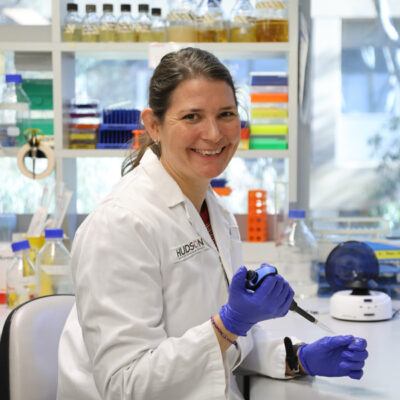How a baby’s sex is determined
By Hudson Institute communications. Reviewed by Professor Vincent Harley
A discovery has been made about how a baby’s sex is determined – it’s not just about the X-Y chromosomes, but involves a ’regulator’ that increases or decreases the activity of genes which decide if we become male or female.

The study by Hudson Institute PhD student, Brittany Croft and Murdoch Children’s Research Institute (MCRI) has been published in the journal Nature Communications.
“The sex of a baby is determined by its chromosome make-up at conception. An embryo with two X chromosomes will become a girl, while an embryo with an X-Y combination results in a boy,” said Ms Croft who was first author of the study.
Role of SRY and SOX9 genes
“The Y chromosome carries a critical gene, called SRY, which acts on another gene called SOX9 to start the development of testes in the embryo. High levels of the SOX9 gene are needed for normal testis development.
“However, if there is some disruption to SOX9 activity and only low levels are present, a testis will not develop resulting in a baby with a disorder of sex development.”
Lead author of the study, Professor Andrew Sinclair (MCRI), said that 90 per cent of human DNA is made up of so called ‘junk DNA or dark matter’ which contains no genes but does carry important regulators that increase or decrease gene activity.
“These regulatory segments of DNA are called enhancers,” he said. “If these enhancers that control testis genes are disrupted it may lead to a baby being born with a disorder of sex development.”
Study findings on SOX9 gene regulation
Professor Sinclair said this study sought to understand how the SOX9 gene was regulated by enhancers and whether disruption of the enhancers would result in disorders of sex development.
“We discovered three enhancers that, together ensure the SOX9 gene is turned on to a high level in an XY embryo, leading to normal testis and male development,” he said.
“Importantly, we identified XX patients who would normally have ovaries and be female but carried extra copies of these enhancers, (high levels of SOX9) and instead developed testes. In addition, we found XY patients who had lost these SOX9 enhancers, (low levels of SOX9) and developed ovaries instead of testes.”
Implications for diagnosing disorders of sex development
Ms Croft said human sex reversal, such as seen in these cases, is caused by gain or loss of these vital enhancers that regulate the SOX9 gene; consequently, these three enhancers are required for normal testes and male development.”
“This study is significant because in the past researchers have only looked at genes to diagnose these patients, but we have shown you need to look outside the genes to the enhancers,” Ms Croft said.
Professor Sinclair said that across the human genome there were about one million enhancers controlling about 22,000 genes.
“These enhancers lie on the DNA but outside genes, in regions previously referred to as junk DNA or dark matter,” he said.
“The key to diagnosing many disorders may be found in these enhancers which hide in the poorly understood dark matter of our DNA.”
Collaborators | Ms Brittany Croft, Dr Rajini Sreenivasan (Hudson Institute and MCRI), Professor Andrew Sinclair, Dr Thomas Ohnesorg, Dr Jacqueline Tan, Ms Jocelyn van den Bergen, Ms Ingrid Knarston, Ms Gorjana Robevska, Dr John Hutson, Dr Katie Ayers, (MCRI), Jacky Hewitt (Monash Childrens' Hospital), Dr Josephine Bowles (University of Queensland), Dr Alexander Quinn, Dr Emanuele Pelosi, Professor Peter Koopman (Institute for Molecular Bioscience), Dr Vincent Corbin (Walter & Eliza Hall Institute), Dung Chi Vu (National Childrens Hospital Vietnam)
This research was supported by | National Health and Medical Research Council (NHMRC), Australian Government Research Training Program Scholarship
Journal | Nature Communications
Title | Human sex reversal is caused by duplication or deletion of core enhancers upstream of SOX9
View publication | https://doi.org/10.1038/s41467-018-07784-9
In this article
About Hudson Institute
Hudson Institute’ s research programs deliver in three areas of medical need – inflammation, cancer, women’s and newborn health. More
Hudson News
Get the inside view on discoveries and patient stories
“Thank you Hudson Institute researchers. Your work brings such hope to all women with ovarian cancer knowing that potentially women in the future won't have to go through what we have!”





